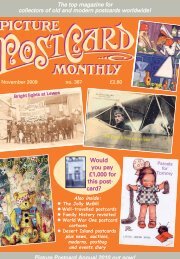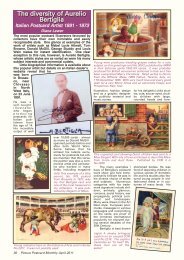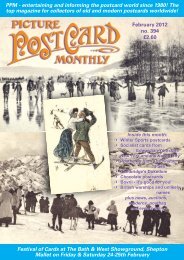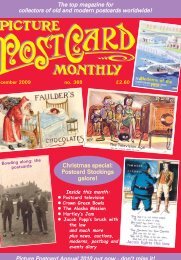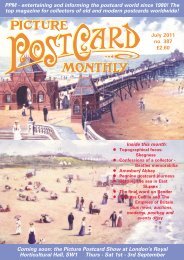PPM revisits Manchester's Belle Vue amusement park - Picture ...
PPM revisits Manchester's Belle Vue amusement park - Picture ...
PPM revisits Manchester's Belle Vue amusement park - Picture ...
You also want an ePaper? Increase the reach of your titles
YUMPU automatically turns print PDFs into web optimized ePapers that Google loves.
Topographical focus<br />
Bournemouth<br />
John Garrett celebrates the bicentenary of<br />
the south coast resort<br />
Bournemouth is a young town, having only just celebrated<br />
its 200th anniversary, unlike its much older<br />
neighbours of Christchurch and Poole. The town lies<br />
in an area surrounding the mouth of the ‘Bourne’<br />
stream on a wild, desolate heathland with a few fishermen’s<br />
hovels on common land used for grazing,<br />
and a few paths crossing the area. Its use in the 18th<br />
century was as a popular route for smugglers, the<br />
most famous of whom was Isaac Gulliver.<br />
The Christchurch enclosure<br />
act of 1802 passed by parliament<br />
enabled much of the<br />
common land to be enclosed<br />
and sold to seven freeholders,<br />
which cleared the way<br />
for plantations of pine trees<br />
to be planted replacing much<br />
of the gorse and heath and<br />
roads were developed from<br />
rough tracks. An inn, long<br />
since gone, was established<br />
to provide facilities between<br />
Christchurch and Poole. In<br />
1796, when the shoreline<br />
between Hengistbury Head<br />
and Sandbanks was recognised<br />
as a possible place for<br />
an invasion by Napoleon, a<br />
troop of Dorset Yeomanry<br />
under the command of Captain<br />
Lewis Dymock<br />
Grosvenor Tregonwell was<br />
responsible for the defence of<br />
The coat of arms was<br />
granted to the town on<br />
March 24th 1891. The<br />
crest on the top<br />
consists of four English<br />
roses surmounted<br />
by a palm tree.<br />
The town’s motto “Pulchritudo<br />
et salubritas” is<br />
below on an ornamental<br />
scroll and means ‘beautiful<br />
and healthy’. The<br />
postcard, postmarked<br />
Bournemouth, June 30,<br />
1905 is one of the ‘Ja-Ja’<br />
heraldic series of cards<br />
designed and produced<br />
in England.<br />
the area. In 1810, whilst<br />
holidaying with his rich<br />
wife Henrietta at Mudeford,<br />
they drove over<br />
the beaches and sand<br />
dunes to the mouth of a<br />
little stream called ‘bourne’<br />
where she fell in love with the<br />
beautiful pine trees, sand<br />
dunes and warm climate.<br />
Captain Tregonwell, whose<br />
main home was at Cranborne,<br />
immediately purchased<br />
8 1 /2 acres from Sir<br />
George Tapps and in 1812,<br />
built a house called ‘The Mansion’<br />
which today<br />
is the site of “The<br />
Royal Exeter<br />
Hotel” in Exeter<br />
R o a d .<br />
Bournemouth<br />
owes its beginnings<br />
to Tregonwell<br />
who<br />
has been<br />
called ‘the<br />
founder of<br />
Bournemouth’.<br />
He certainly<br />
was the first to<br />
Bournemouth, The Russell-Cotes Art Gallery and Museum<br />
In 1894 Sir Merton Russell-Cotes Mayor of Bournemouth<br />
built the East Cliff Hall on the East Cliff as a birthday present<br />
for Annie, his wife. It was to be their private house<br />
and on completion he announced he would give a large<br />
part of his art collection and his wife, Annie, would give the<br />
house and most of its contents to the town provided they<br />
could live there during their lifetimes. It was opened as the<br />
Russell-Cotes Art Gallery and Museum by Princess Beatrice,<br />
Queen Victoria’s youngest daughter in 1919. This card<br />
is unused and has no indication of printer or publisher.<br />
see its potential as a health<br />
resort for the wealthy, sick,<br />
and elderly, but times have<br />
changed and now the town is<br />
regarded as one of the most<br />
popular holiday resorts on<br />
the south coast with a population<br />
of 165,000. Tregonwell<br />
died on January 18th 1832<br />
aged 73 and his wife Henrietta<br />
two months later aged 76.<br />
They are buried in the Tregonwell<br />
tomb in St. Peter’s<br />
churchyard, the town’s mother<br />
church. Bournemouth’s<br />
remote location from London<br />
meant its development into a<br />
seaside resort was slow but<br />
by the 1850s the town was<br />
beginning to take shape. The<br />
Bournemouth Improvement<br />
Act of 1856 and the Board of<br />
Commissioners began by<br />
providing the facilities and<br />
publicity needed to make it a<br />
popular resort, the census of<br />
1851 recording a jump from<br />
700 to nearly 17,000 in 1881,<br />
and its image as a centre for<br />
the wealthy and ailing grew.<br />
The Russell-Cotes family<br />
came from Glasgow because<br />
of Mr. Merton’s poor health,<br />
and after visiting the town<br />
and staying at the Royal<br />
Bath Hotel, he acquired it in<br />
1880. Later, as Sir Merton,<br />
Mayor of Bournemouth, in<br />
1894 he built the Russell-<br />
Cotes museum on the East<br />
Cliff as a birthday present for<br />
his wife, Annie. Originally<br />
called ‘East Cliff Hall’, it is<br />
now the Russell-Cotes Museum<br />
and Art Gallery and well<br />
worth a visit. They donated<br />
the house and contents to<br />
the town provided they could<br />
live there during their lifetimes.<br />
In 1893 Sir Merton<br />
became the only Mayor of<br />
Bournemouth who had not<br />
been a councillor. He was<br />
made a freeman in 1908 and<br />
knighted a year later. Travellers<br />
wanti-<br />
The earliest recorded postcard from<br />
Bournemouth is dated 15th April 1897 printed<br />
in Holstein, Germany. Originally classed<br />
as a court card, the message appeared on<br />
the front as only the address was allowed<br />
on the back of the card prior to 1902 when<br />
the divided back type of cards were sanctioned<br />
by the post office. This card, dated<br />
25 Feb 1899, shows an early coloured view<br />
of “The Chine” and was sent from the Durley<br />
Hall, Durley Chine with a very clear<br />
Bournemouth cancel of 25 Feb 1899 printed<br />
by the Pictorial Stationary Co at the<br />
fine art works, Holstein.<br />
14 <strong>Picture</strong> Postcard Monthly July 2010



